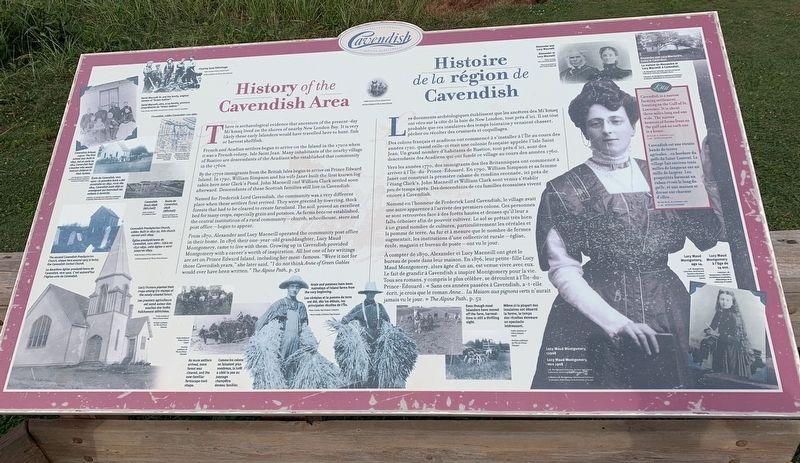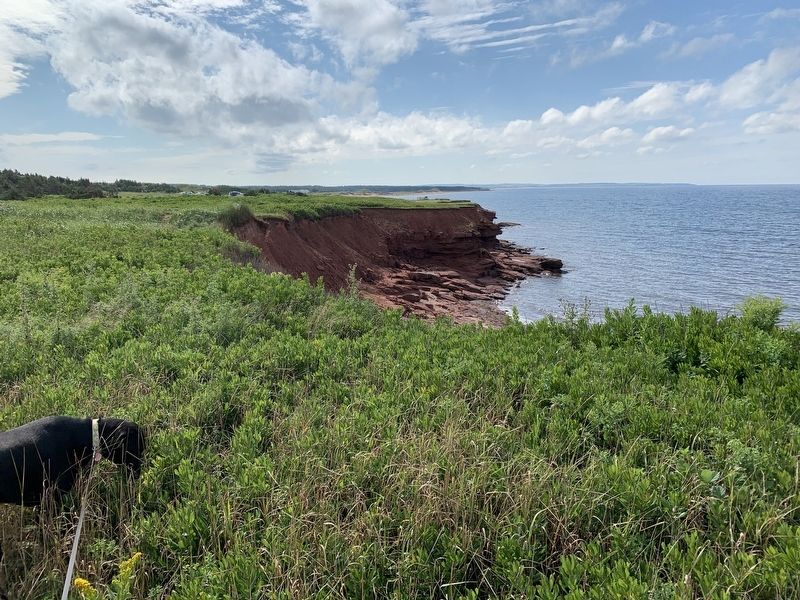Cavendish in Queens County, Prince Edward Island — The Atlantic Provinces (North America)
Cavendish Dunelands Trail/Cavendish Sentier Dunelands
History of the Cavendish Area/Histoire de la région de Cavendish.
Inscription.
History of the Cavendish Area.
French and Acadian settlers began to arrive on the Island in the 1720’s when it was a French colony, Isle Saint Jean. Many inhabitants of the nearby village of Rustico are descendents of the Acadians who established that community in the 1760’s. .
By the 1770’s immigrants from the British Isles began to arrive on Prince Edward Island. In 1790, William Simpson and his wife Janet built the first known log cabin here near Clark’s Pond. John Macneil and William Clark settled soon afterward. Descendents of these Scottish families still live in Cavendish. .
Named for the Frederick Lord Cavendish, the community was a very different place when these settlers first arrived. They were greeted by towering, thick forests that had to be cleared to create farmland. The soil proved an excellent bed for many crops, especially grain and potatoes. As farms became established, the central institutions of a rural community – church, schoolhouse, stores, and post office -- began to appear. .
From 1870, Alexander and Lucy Macneil operated the community post office in their home. In 1876 their one-year-old granddaughter, Lucy Maud Montgomery, came to live with them. Growing up in Cavendish provided Montgomery with a career’s worth of inspiration. All but one of her writings are set on Prince Edward Island, including her most-famous. “Were it not for those Cavendish years,” she later said, “I do not think Anne of Green Gables would ever have been written.” The Alpine Path, p.52.
Les documents archéologiques établissent que les ancêtres des Mi’kmaq ont vécu sur la côte de la baie de New London, tout près d’ici. Il est tout probable que ces insulaires des temps lointains y venaient chasser, pécher ou récolter des crustacés et coquillages. .
Des colons français et acadiens ont commencé à s’installer à l’Île au cours des années 1720, quand celle-ci était une colonie française appelée l’Isle Saint Jean. Un grand nombre d’habitants de Rustico, tout près d’ici, sont des descendants des Acadiens qui ont fondé ce village au cours des années 1760. .
Vers les années 1770, des immigrants des îles Britanniques ont commencé â arriver à l’Île –du-Prince-Édouard. En 1790, William Simpson et sa femme Janet ont construit la première cabane de rondins recensée, ici près de l’étang Clark’s. John Macneill et William Clark sont venus s’établir peu de temps après. Des descendants de ces familles écossaises vivent encore à Cavendish. .
Nommé en l’honneur de Frederick Lord Cavendish, le village avait une autre apparence à l’arrivée des premiers colons. Ces personnes se sont retrouvées face à des forêts hautes et denses qu’il leur a fallu déboiser afin de pouvoir cultiver. Le sol se prêtait très bien à un grand nombre de cultures, particulièrement les céréales et la pomme de terre. Au fur et à mesure que le nombre de fermes augmentait, les institutions d’une collectivité rurale – église, école, magasin et bureau de poste – ont vu le jour. .
À compter de 1870, Alexander et Lucy Macneill ont géré le bureau de poste dans leur maison. En 1876, leur petite-fille Lucy Maud Montgomery, alors âgée d’un an, est venue vivre avec eux. Le fait de grandir à Cavendish a inspiré Montgomery pour la vie. Tous ses romans, y compris le plus célèbre, se déroulent à l’Île-du-Prince-Édouard: « Sans ces années passées à Cavendish, a-t-elle écrit, je crois que le roman Anne … La Maison aux pignons verts n’aurait jamais vu le jour. » The Alpine Path, p.52
Topics. This historical marker is listed in these topic lists: Native Americans • Settlements & Settlers. A significant historical year for this entry is 1790.
Location. 46° 30.005′ N, 63° 22.866′ W. Marker is in Cavendish, Prince Edward Island, in Queens County. Marker can be reached from Gulf Shore Parkway West. Marker can be reached from the Cavendish Beach East parking lot. Touch for map. Marker is in this post office area: Cavendish PE C0A 1M0, Canada. Touch for directions.
Other nearby markers. At least 8 other markers are within 10 kilometers of this marker, measured as the crow flies. A different marker also named Cavendish Dunelands Trail/Cavendish Sentier Dunelands (here, next to this marker); a different marker also named Cavendish Dunelands Trail/Cavendish Sentier Dunelands (about 120 meters away, measured in a direct line); a different marker also named Cavendish Dunelands Trail/Cavendish Sentier Dunelands (about 180 meters away); Lucy Maud Montgomery (approx. 1.3 kilometers away); North Rustico War Memorial (approx. 6.9 kilometers away); Rev. John Geddie D.D. (approx. 9.6 kilometers away); Springbrook World War II Memorial (approx. 9.7 kilometers away); Springbrook First World War Memorial (approx. 9.7 kilometers away). Touch for a list and map of all markers in Cavendish.
Credits. This page was last revised on September 11, 2019. It was originally submitted on September 10, 2019, by Steve Stoessel of Niskayuna, New York. This page has been viewed 144 times since then and 15 times this year. Photos: 1, 2. submitted on September 10, 2019, by Steve Stoessel of Niskayuna, New York. • Andrew Ruppenstein was the editor who published this page.

